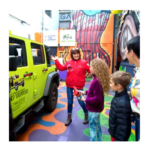CALL US! 1-415-766-2722
Fun@SanFranciscoJeepTours.com
The Panama-Pacific International Exposition (PPIE) was held in San Francisco, California, in 1915 to celebrate the completion of the Panama Canal and showcase San Francisco’s recovery from the devastating 1906 earthquake.
The exposition covered over 600 acres of land in the Marina District, now known as the Palace of Fine Arts.
The PPIE lasted for ten months, from February 20 to December 4, 1915, and attracted millions of visitors.
The fair featured numerous exhibits and pavilions representing different countries and industries, showcasing advancements in technology, arts, agriculture, and more.
One of the main attractions at the PPIE was the Tower of Jewels, a 43-story tower covered in more than 100,000 pieces of cut glass and illuminated with thousands of electric lights.
The Palace of Fine Arts, designed by architect Bernard Maybeck, was one of the few structures from the PPIE that was preserved and still stands today.
The PPIE introduced several significant technological innovations, including the first public use of neon lights, a giant Ferris wheel, and a working model of the Panama Canal.
The exposition also featured the first transcontinental telephone call, connecting President Woodrow Wilson in Washington, D.C., with the fair’s president in San Francisco.
The PPIE was a celebration of cultural diversity, with performances from different countries and regions, including Native American tribes, Chinese opera, and Hawaiian hula dancers.
The PPIE attracted notable figures such as Thomas Edison, Helen Keller, and aviator Amelia Earhart, who made her first public appearance at the fair as a young girl.
The fair’s Fine Arts Palace showcased artworks from around the world, including famous pieces by renowned artists such as Claude Monet, Pierre-Auguste Renoir, and John Singer Sargent.
The PPIE had its own transportation system, including a miniature railway called the Joy Line that transported visitors around the fairgrounds.
The PPIE contributed to the economic growth of San Francisco, generating millions of dollars in revenue and boosting tourism and trade in the region.
The fair was a major success and helped to restore San Francisco’s reputation as a thriving and cosmopolitan city after the devastating earthquake and fire of 1906.
The legacy of the PPIE can still be seen in San Francisco today, particularly in the Palace of Fine Arts, which has become an iconic landmark and a popular venue for events and exhibitions.
The Panama-Pacific International Exposition was a landmark event that not only celebrated human achievement and technological advancement but also demonstrated resilience and optimism in the face of adversity.
The Panama-Pacific International Exposition (PPIE) of 1915 was a world’s fair held in San Francisco, California. Its primary purpose was to celebrate the completion of the Panama Canal, but it was also an opportunity to showcase San Francisco’s recovery from the devastating 1906 earthquake and fire. The exposition covered an area of 635 acres and was situated along the northern shore of the city, in what is now the Marina District.
The idea behind the exposition was to demonstrate human achievement in various fields, including arts, agriculture, science, and industry. The fair also aimed to promote trade and to foster better relationships between the Pacific Rim countries and the rest of the world. It officially opened on February 20, 1915, and ran until December 4, 1915, attracting over 18 million visitors.
The legacy of the PPIE is still visible in San Francisco today. While most of the exposition’s grand buildings were meant to be temporary and were dismantled after the fair, a few remnants and influences remain. The most notable survivor is the Palace of Fine Arts, which was rebuilt in the 1960s to serve as a permanent structure and continues to be a popular attraction for both locals and tourists. The site of the exposition, now largely residential and recreational, still reflects the grand vision of the fair in its layout and in some of the surviving landscape and architectural elements.
Visiting the remnants of the Panama-Pacific International Exposition, especially the Palace of Fine Arts, offers a glimpse into early 20th-century optimism and ingenuity. It’s a chance to reflect on how events like the PPIE have shaped the cultural and physical landscape of San Francisco. The area not only serves as a monument to human achievement and resilience but also as a beautiful and peaceful retreat within the bustling city.
The Panama-Pacific International Exposition of 1915 was a pivotal event in San Francisco’s history, symbolizing not only the city’s recovery and resurgence but also the dawn of a new era of global connectivity and cultural exchange.
 Experience San Francisco Like Never Before – Book Your Private Jeep Tour Now!
Experience San Francisco Like Never Before – Book Your Private Jeep Tour Now!See the city’s top sights on your terms with a Private Jeep Tour! Your personal guide takes you to San Francisco’s must-see locations, ensuring unforgettable views and photo stops—including a breathtaking drive across the Golden Gate Bridge.
Don’t just visit—experience San Francisco in style! Spots fill fast—Book your Jeep adventure today!
